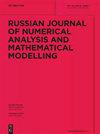SIMUG – finite element model of sea ice dynamics on triangular grid in local Cartesian basis
IF 0.6
4区 数学
Q4 MATHEMATICS, APPLIED
Russian Journal of Numerical Analysis and Mathematical Modelling
Pub Date : 2023-06-01
DOI:10.1515/rnam-2023-0012
引用次数: 0
Abstract
Abstract The paper presents the dynamical core of the new sea ice model SIMUG (Sea Ice Model on Unstructured Grid) on the A- and CD-types of unstructured triangular grids in the local-element basis on sphere. Three standardized box tests to reproduce the Linear Kinematic Features (LKFs), and the short-term forecast in the real Arctic Ocean geometry with the realistic atmosphere and ocean forcing demonstrate the model quality compared to other sea ice models like CICE, FESOM, MITgcm, and ICON-O. The distinctive features of the model presented are a wide choice of transport schemes, and the new numerical implementation with the serial and parallel C++ coding and INMOST, Ani2D, and Ani3D packages to deal with unstructured grids. Code profiling and scalability assessment are carried out. In general, the A-version of the ice drift model works faster, but has fewer degrees of freedom on the same grid. Due to the increase in the degrees of freedom, the model on the CD grid gives ultra-resolution of LKFs, but requires more strict conditions for stability.SIMUG–基于局部笛卡尔坐标的三角形网格上的海冰动力学有限元模型
提出了基于球面局部元的A型和cd型非结构化三角形网格海冰模型SIMUG (sea ice model on Unstructured Grid)的动力学核心。与CICE、FESOM、MITgcm和ICON-O等其他海冰模式相比,模拟线性运动特征(LKFs)的三个标准化箱试验和具有真实大气和海洋强迫的真实北冰洋几何形状的短期预报证明了模式的质量。该模型的显著特点是具有广泛的传输方案选择,以及采用串行和并行c++编码和INMOST、Ani2D和Ani3D软件包处理非结构化网格的新数值实现。进行了代码分析和可伸缩性评估。一般来说,a版本的冰漂移模型工作得更快,但在同一网格上的自由度更少。由于自由度的增加,CD网格上的模型给出了LKFs的超分辨率,但对稳定性的要求更严格。
本文章由计算机程序翻译,如有差异,请以英文原文为准。
求助全文
约1分钟内获得全文
求助全文
来源期刊
CiteScore
1.40
自引率
16.70%
发文量
31
审稿时长
>12 weeks
期刊介绍:
The Russian Journal of Numerical Analysis and Mathematical Modelling, published bimonthly, provides English translations of selected new original Russian papers on the theoretical aspects of numerical analysis and the application of mathematical methods to simulation and modelling. The editorial board, consisting of the most prominent Russian scientists in numerical analysis and mathematical modelling, selects papers on the basis of their high scientific standard, innovative approach and topical interest.
Topics:
-numerical analysis-
numerical linear algebra-
finite element methods for PDEs-
iterative methods-
Monte-Carlo methods-
mathematical modelling and numerical simulation in geophysical hydrodynamics, immunology and medicine, fluid mechanics and electrodynamics, geosciences.

 求助内容:
求助内容: 应助结果提醒方式:
应助结果提醒方式:


